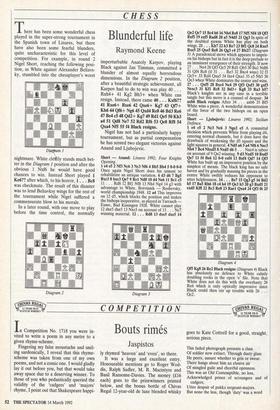CHESS
Blunderful life
Raymond Keene
There has been some wonderful chess played in the super-strong tournament in the Spanish town of Linares, but there have also been some fearful blunders, quite uncharacteristic for this level of competition. For example, in round 2 Nigel Short, reaching the following posi- tion, as White against Alexander Beliays- ky, stumbled into the chessplayer's worst
Dfogivam 1
nightmare. White cleirly stands much bet- ter in the Diagram 1 position and after the obvious 1 Nxf6 he would have good chances to win. Instead Short played 1 Ke6?? after which, to his horror, 1 I. . . Bc8 was checkmate. The result of this disaster was to lend Beliavksy wings for the rest of the tournament while Nigel suffered a commensurate blow to his morale.
In a later round, with one move to play before the time control, the normally
Diagram 2
imperturbable Anatoly Karpov, playing Black against Jan Timman, committed a blunder of almost equally horrendous dimensions. In the Diagram 2 position, after a beautiful strategic achievement, all Karpov had to do to win was play 40 . . . Rxh4+ 41 Kg2 Bh3+ when White can resign. Instead, there came 40 . . . Kxf6?? 41 Rxe6+ Bxe6 42 Qxe6+ Kg7 43 Qfl+ Kh6 44 Qf6+ Ng6 45 Qxd4 Re8 46 Bd3 Re6 47 Be4 c5 48 Qd2+ Kg7 49 Rdl Qe5 50 Kh3 a4 51 Qd8 Ne7 52 Rd2 Rf6 53 Qe8 Rf8 54 Qxa4 Nf5 55 f4 Black resigns.
Nigel has not had a particularly happy tournament, but as partial compensation he has scored two elegant victories against Anand and Ljubojevic.
Short — Anand: Linares 1992; Four Knights Opening.
1 e4 e5 2 Nf3 Nc6 3 Nc3 Nf6 4 Bb5 Bb4 5 0-0 0-0 Once again Nigel Short does his utmost to rehabilitate an antique variation. 6 d3 d6 7 Bg5 Bxc3 8 bxc3 Qe7 9 Rel Nd8 10 d4 Ne6 11 Bc1 c5 11 . . . Rd8 12 Bfl Nf8 13 Nh4 Ng4 14 g3 with advantage to White, Botvinnik — Reshevsky, world championship 1948. 12 a4 This improves on 12 d5, which blocks the position and makes the bishops inoperative, as played in Tarrasch — Euwe, Bad Kissingen 1928. White cannot play 12 dxe5 dxe5 13 Nxe5 on account of 13 . . . Nc7, winning material. 12 . . . Rd8 13 dxe5 dxe5 14 Diagram 3
Qe2 Qc7 15 Bc4 h6 16 Nh4 Re8 17 Nf5 Nf4 18 Qf3 Bxf5 19 exf5 Rad8 20 a5 N4d5 21 Qg3 In spite of the doubled pawns White has play on both wings. 21 . . . Kh7 22 h3 Re7 23 Bfl Qc8 24 Rxe5 Rxe5 25 QxeS Re8 26 Qg3 c4 27 Bb2I! (Diagram 3) A paradoxical move which appears to impris- on his bishops but in fact it is the deep prelude to an imminent resurgence of their strength. If now 27 . . . Ne4 28 Qf3 Qc5 29 Rdl Qb5 30 Bal Ndf6 31 Qf4 Rc8 (if 31 . . . Re5 32 Bxc4 wins) 32 f3 Qc5+ 33 Rd4 Qxa5 34 fxe4 Qxa 1 35 e5 Nh5 36
Qe3 when White dominates the centre and wins. 27 . . . QxfS 28 Bxc4 Ne4 29 Qf3 Qxf3 30 gxf3 Nexc3 31 Kfl Rc8 32 Bd3+ Kg8 33 Ra3 b5? Black's knights are in any case in a terrible tangle but this move is a counsel of despair. 34 axb6 Black resigns After 34 . . . axb6 35 Bf5 White wins a piece. A wonderful demonstration of the force of the two bishops on an open board.
Short — Ijubojevic: Linares 1992; Sicilian Defence.
1 e4 c5 2 Nc3 Nc6 3 Nge2 e5 A committal decision which prevents White from playing d4, entering normal channels, but it does have the drawback of weakening the d5 square and the light squares in general. 4 Nd5 a6 5 a4 Nf6 6 Nec3 NM 7 Bc4 Nbxd5 8 NxdS d6 8 . . . Nxe4 is taboo on account of 9 Qe2 winning. 9 d3 NxdS 10 BxdS Qe7 11 f4 Be6 12 0-0 exf4 13 Bxf4 Qd7 14Qf3 White has built up an impressive position by the simplest of means. The black king has no safe haven and by gradually massing his pieces in the centre White swiftly reduces his opponent to utter helplessness. 14 . . . Be7 15 Qg3 g5 16 Bd2 h5 17 Ba5 Rh6 18 c4 h4 19 Qe3 h3 20 g3 BxdS 21 exd5 KIS 22 Bc3 Re8 23 Rael Qxa4 24 Qf3 f6 25 Diagram 4
Qf5 Kg8 26 Re2 Black resigns (Diagram 4) Black has absolutely no defence to White calmly doubling rooks in the open `e' file. Note that White does not do this with the overhasty 26 Re6 which is only optically impressive since Black could then stir up trouble with 26 . . . Qc2.


























































 Previous page
Previous page